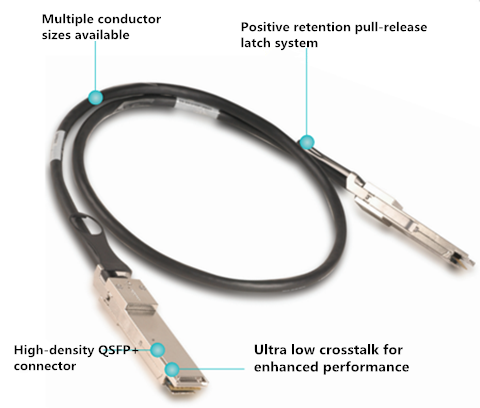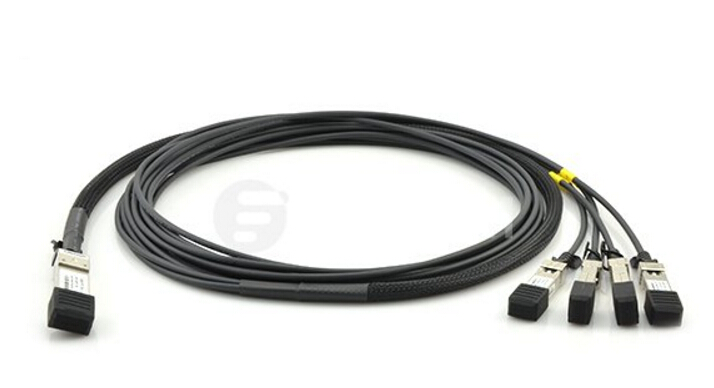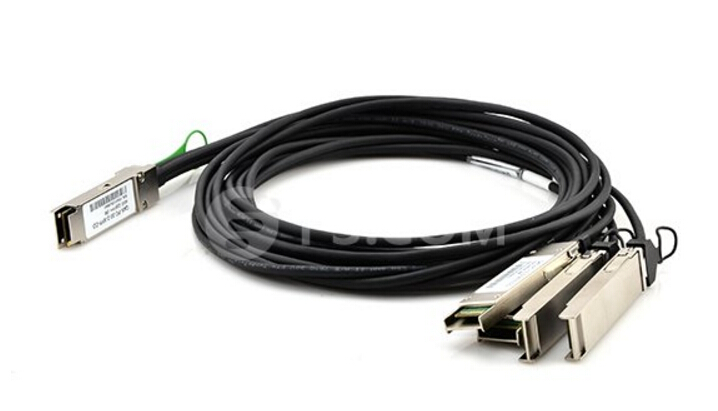The epidemic of switching and routing, cloud computing and virtualized servers is boosting the demand for higher network speeds, greater scalability, and higher levels of performance and reliability in data centers. Therefore, 1G and 10G are no longer capable of satisfying the increasing bandwidth needs, thus migration to 40G or 100G becomes an imperative and spontaneous alternation to cope up with the trend. This article will introduce 40G QSFP+ direct attach copper cable (DAC)—a cost-effective and ideal solution to support 40G applications.
What Is 40G QSFP+ DAC?
To make it easier to understand, we should figure out what DAC is at first. Direct attach cable (DAC) is a form of high speed cable with a transceiver shaped device on either end used to connect switches to routers or servers. DAC cables are not real optics and their components are without optical lasers, and it is much cheaper than regular optics. The low cost, low power consumption and high performances of DACs make it a favorable option for storage area network (SAN), data centers and high-performance computing connectivity.
Types of 40G QSFP+ DAC
Generally, there exist three types of 40G QSFP+ DAC cables—40G QSFP+ to QSFP+ DAC, 40G QSFP+ to 4 SFP+ DAC and 40G QSFP+ to 4 XFP DAC.
40G QSFP+ to QSFP+ DAC
QSFP+ to QSFP+ DAC consists of a cable assembly that connects two QSFP+ modules respectively at each end of the cable. This kind of cable uses integrated duplex serial data links to ensure bidirectional communication. QSFP+ to QSFP+ DACs are usually employed in rather short distances and provide an efficient way to establish a 40G link between QSFP+ ports of QSFP+ switches with less cost.

40G QSFP+ to 4 SFP+ DAC
The migration from 10G to 40G Ethernet may be a gradual process. Which means it is possible that when you plan to deploy switches with 40G Ethernet ports, but the existing servers are still with 10G Ethernet ports. Then, QSFP+ to 4 SFP+ DAC are ready to solve the problem. These cables connect to a 40G QSFP port of a switch on one end and to four 10G SFP+ ports of a switch on the other end, which allows a 40G Ethernet port to be used as four independent 10G ports thus providing increased density while permitting backward compatibility and a phased upgrade of equipment.

40G QSFP+ to 4 XFP DAC
The QSFP+ to 4 XFP DAC is not commonly seen as the former two types. It is a 40GBase QSFP+ hybrid passive cable with a QSFP+ connector at one end and 4 XFP connectors at the other. It’s an application for link with QSFP+ port on 40Gbps rate switch or host and feed up to 4 upstream 10Gbps switch or host.

Advantages of 40G QSFP+ DAC
In all, 40G QSFP+ DAC provides inexpensive and reliable 40G speed connections and serves as an optimum choice to migrate from 10G to 40G Ethernet. The main advantages of QSFP+ DAC are listed below.
- Enough data rate for various applications—DAC cables can support higher data rates than traditional copper interfaces. In fact, DAC cables can offer a highly cost-effective way to establish a 40G link between QSFP+ ports of QSFP+ switches within racks and across adjacent racks.
- Interchangeability—With the advancements of copper cable technology, copper DACs are interchangeable and hot swappable with fiber optic modules.
- Cheap—Since copper cables are much cheaper than fiber cables, DACs are cost-effective solution over optical transceivers and AOCs for short reach applications.
Conclusion
The deployment of 40G QSFP+ DAC cable to ensure higher speed and more reliable network performance is on the rise, meanwhile it also contributes to reduce the cost of short reach connectivity significantly. Implementing 40G QSFP+ DAC cable can be regarded as a win-win strategy to anyone who pursues high bandwidth without high expenditure.
First published: http://www.fiber-optic-solutions.com/2292.html

No comments:
Post a Comment